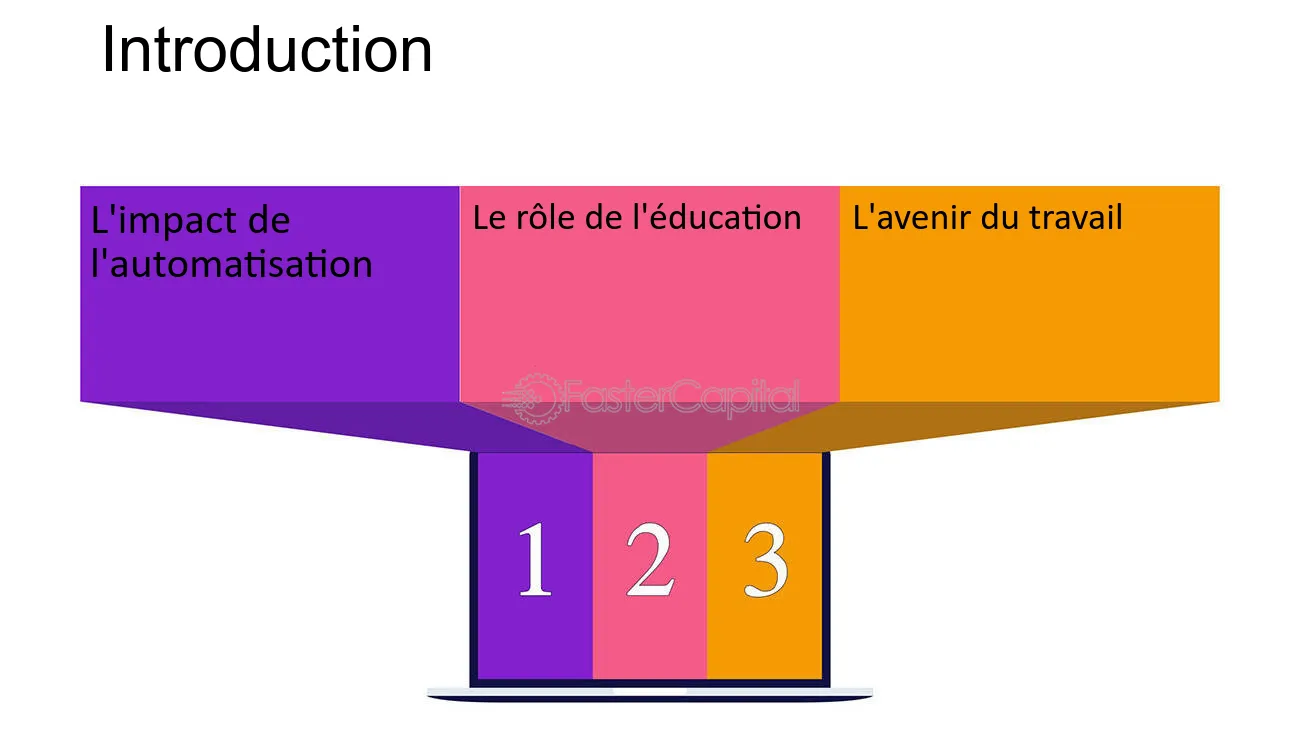Table des matières
ToggleThe Challenges of Technological Unemployment
Technological unemployment results from rapid automation and digitization transforming industries, rendering certain skills obsolete and creating new job requirements. This phenomenon causes an imbalance between labor supply and demand, particularly impacting sectors where technology replaces routine and repetitive human tasks.
The challenges of technological unemployment are multiple and complex. On one hand, there is a growing necessity for workers to train and acquire new skills suited to emerging jobs. On the other hand, companies must invest in retraining and ongoing education programs to support their employees.
The effects of technological unemployment are also evident at the macroeconomic level. Here are some key points:
- Increasing income inequality: The heightened demand for specialized skills and the decline of low-skilled jobs can widen the wage gap.
- Adaptation of the education system: Institutions must revise their programs to prepare students for tomorrow’s jobs, including disciplines such as artificial intelligence, robotics, and data science.
- Social security and the economy: The redistribution of resources and the enhancement of social safety nets become essential to support affected workers.
The industry 4.0 technologies, such as the Internet of Things (IoT) and Fab Labs, have the potential to reinvent production processes, offering new opportunities but also requiring rapid workforce adaptation. The implementation of smart contracts can also optimize supply chain management, but necessitates new legal and technological skills.
To mitigate the effects of technological unemployment, collaboration between governments, businesses, and educational institutions is essential. Initiatives such as establishing ongoing training programs and employment support policies can help navigate this complex transition.
Impact on the Labor Market
Technological unemployment stems from automation and the introduction of advanced technologies that replace tasks previously performed by humans. With the rise of industrial robots, artificial intelligence, and cloud computing, many jobs are threatened by this rapid transformation.
Manufacturing industries, in particular, have seen significant transformation due to technologies such as OPC-UA, which optimize production processes. The concept of on-demand manufacturing and the rise of Fab Labs further reinforce this trend, drastically altering the demands for skilled labor.
The labor market is profoundly affected by these developments. Professions once considered secure are now facing a growing threat of extinction or transformation. Here are some direct impacts:
- Reduction of jobs in automated sectors: Many production tasks are now performed by machines, decreasing the demand for manual workers.
- New skills needs: Companies now seek talent with skills in advanced technologies, requiring constant knowledge updates.
- Training and retraining: Workers must continuously train to remain relevant and competitive in a rapidly changing technological environment.
Operational efficiency is at the heart of companies’ concerns, leading to a growing interest in predictive maintenance and lean production. Smart contracts are also being explored to enhance supply chain management, thereby ensuring increased product quality and reliability. This transformation requires ongoing adaptation of skills and a deep understanding of new technologies.
Evolution of Required Skills
The technological unemployment, known as “Skill Shift,” represents a significant challenge in the rapid evolution of technologies. Many sectors are undergoing transformation due to automation, artificial intelligence, and other digital advancements. This phenomenon results in a substantial change in required skills, often before individuals can adapt.
The challenges of technological unemployment manifest primarily through the need for rapid adaptation to new technologies. Companies must adopt a proactive strategy to reassess and retrain their employees to maintain operational efficiency. This also involves implementing ongoing training programs and personal development opportunities so that employees can keep pace with innovations.
Predictive maintenance, lean production, and the use of Fab Labs are examples of trends changing expectations regarding workers’ skills. Additionally, the applications of OPC-UA for process optimization require specific knowledge, making employee retraining essential.
In this context, the evolution of required skills is illustrated by a growing demand for talent capable of mastering and integrating technologies such as:
- Artificial Intelligence
- Robotics
- Cloud Computing
- Smart Contracts for supply chain management
Adaptation Strategies and Solutions

Technological unemployment, also known as “Skill Shift,” arises from the rapid advancements in technologies and their impact on the labor market. Indeed, the introduction of artificial intelligence, robotics, and cloud computing fundamentally alters the nature of available jobs. Many traditional roles are disappearing or evolving, requiring new technical skills, leading to a mismatch between job supply and demand.
To cope with these changes, several adaptation strategies can be implemented. One of the first measures is to turn to continuing education and skills development. Professionals can thus reskill by learning new technologies or enhancing their existing skills.
Companies can encourage their employees to follow development programs. Additionally, they can adopt technological solutions to automate routine tasks while providing growth opportunities for their employees in higher-value roles.
- Online training: Platforms offering specialized courses allow for acquiring new skills.
- Mentoring: Companies can establish mentoring programs to foster knowledge transfer.
- Academic collaborations: Establish partnerships with educational institutions to adapt programs to market needs.
The adaptation of public policies is also crucial. Governments can invest in technological education and promote initiatives to facilitate the transition of workers to new sectors. For example, tax incentives can be implemented to encourage companies to train their employees.
Workers need to be proactive by developing a culture of flexibility and resilience. Adopting a mindset of lifelong learning and staying informed about the latest technological trends can greatly aid in navigating this period of rapid transformation.
Training and Professional Retraining
Technological unemployment, often referred to as Skill Shift, refers to job loss caused by automation and technological innovation. This rapid transformation poses major challenges for workers whose skills become obsolete in the face of technological advancements. To adapt to these changes, several strategies and solutions can be considered.
One of the main strategies is to encourage skill flexibility. Companies must invest in continuing education to enable their employees to keep up with technological advancements. This can include online courses, certification programs, or practical workshops.
Collaboration between companies and educational institutions is also essential. By aligning training programs with current and future labor market needs, it is possible to prepare employees for new roles. Moreover, it is important to create career paths that integrate stages of skills reassessment and updating.
Another crucial aspect is professional retraining. For workers whose jobs are most threatened by automation, retraining can offer a new pathway. For example, emerging professions in data science, cybersecurity, or green technologies can represent new opportunities.
- Offer training programs specific to these new jobs.
- Encourage lifelong learning to ensure continuous adaptation.
- Provide accessible online training platforms tailored to individual needs.
Proactively identifying transferable skills and implementing mentoring or coaching can also play a key role in the success of retraining efforts.
In summary, digital transformation and automation require a dynamic and proactive adaptation of skills. Adaptation strategies must include continuing education, professional retraining, and cross-sector collaboration to address the challenges posed by technological unemployment.
Role of Businesses and Governments
Technological unemployment, also called “Skill Shift,” manifests when technological advancements replace certain human skills, creating a gap between current skills and those required in the labor market. This evolution can be disruptive, but there are adaptation strategies and solutions to mitigate these effects.
Individuals can also take steps to remain relevant in a constantly evolving world. Engaging in continuing education and professional retraining allows for the development of new technical skills. Additionally, learning interpersonal and transversal skills, such as problem-solving, critical thinking, and project management, can enhance employability.
For organizations, investing in employee training is essential. Implementing internal training and mentoring programs can help reduce the skills gap. By taking a proactive approach, companies can not only retain their employees but also maintain their competitiveness.
Governments also play a crucial role. By providing financial support for professional training and promoting public retraining initiatives, they can facilitate the transition of workers affected by technological unemployment. Establishing partnerships with businesses to co-create training programs tailored to market needs can also be beneficial.
Key interventions may include:
- Establishing curricula tailored to emerging technologies.
- Supporting the teaching of STEM (Science, Technology, Engineering, and Mathematics) from an early age.
- Creating robust retraining and continuing education policies.
By exploring these avenues, it is possible to minimize the impacts of technological unemployment and ensure a smooth transition to a more equitable future of work.





